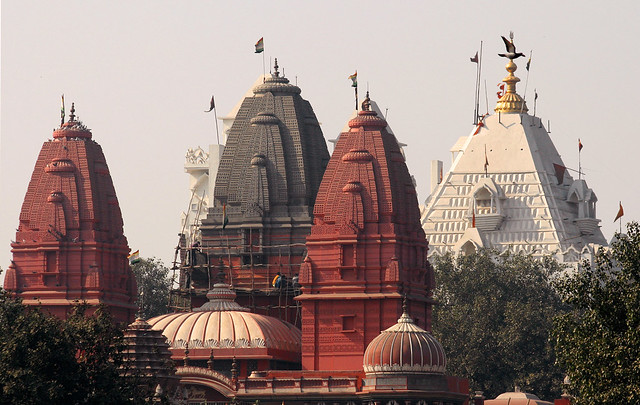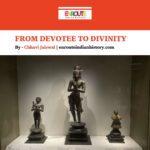
Jainism, with its profound emphasis on non-violence (Ahimsa) and rigorous self-discipline, presents a unique tapestry of beliefs and practices that distinguish it from other religious traditions. This ancient faith is characterized by its ascetic nature, commitment to purity, and strict ethical codes, which guide the lives of its adherents. While Jain doctrine traditionally downplays the role of rituals involving invocation, offerings, and propitiation, popular practices have adapted to include the veneration of idols. These idols, which symbolize the Tirthankaras—Jain spiritual leaders who have attained liberation—act as focal points for worship and devotion, reflecting the community’s spiritual aspirations and deep-seated reverence for their teachings. Through a combination of philosophical tenets and ritual practices, Jainism fosters a rich spiritual environment that invites followers to cultivate inner peace and ethical living.
Worship in Jain Temples: Bhavapuja and Dravyapuja
Entering a Jain temple is a deeply respectful and spiritual experience that involves a series of traditional practices linked to Jain worship, which encompasses two primary forms: Bhavapuja and Dravyapuja. As you approach the temple, it is essential to dress modestly, reflecting the sanctity of the space. Clean, simple clothing is preferred, and items made from leather should be avoided. Before entering, worshippers must remove their footwear at the designated area outside the temple, signifying respect for the sacred ground. Once you are ready to enter, it is customary to say “Nisihi,” which translates to “giving up,” symbolizing the renunciation of worldly attachments. This phrase reflects the spirit of both Bhavapuja and Dravyapuja.
Bhavapuja emphasizes internal spiritual practices, focusing on meditation and mental devotion to the Tirthankaras without the need for physical idols or material offerings. This form of worship is commonly practiced by mendicants and laypeople who may not have access to elaborate rituals. For those engaging in Dravyapuja, or formal worship, the ritual begins with the devotee bathing and donning clean clothes as a sign of respect. Upon entering the temple, worshippers typically recite the Namokar Mantra, a significant Jain prayer acknowledging the five supreme beings and promoting humility and spiritual liberation.

(Source- https://chantal-jumel-kolam-kalam.com/en/jain-rice-designs-to-liberate-the-soul/; A Jain devotee doing Puja)
The process progresses to the Astadravyapuja, an eight-fold offering that includes items such as rice, water, sandalwood paste, and flowers. The use of rice in these offerings holds special significance; it symbolizes nourishment, purity, and sustenance, representing the offering of one’s life force and devotion to the Tirthankara. By offering rice, devotees express their gratitude for sustenance while recognizing the impermanence of material wealth, reflecting Jainism’s emphasis on non-attachment.
A pivotal aspect of this ritual is the Abhisheka, where the idol is bathed with water, symbolizing the purification of the soul. This act mirrors the legend of the Tirthankaras’ birth, during which they were bathed by Indra, the king of gods. As devotees engage in worship, they may recite sacred verses, further enhancing the spiritual atmosphere. The act of Pradakshina, or circumambulating the idol in a clockwise direction, expresses reverence and devotion. This practice signifies respect and serves as a form of meditation, allowing worshippers to center their thoughts on the divine. The ritual culminates with the Santipatha, a prayer for universal peace, where worshippers seek blessings for the prosperity and welfare of their nation, community, and environment. This structured approach to worship reflects the deep spiritual significance Jainism places on both internal devotion and outward expressions of reverence.
Another significant ritual in Jain temples is the installation of idols, known as “Jinabimbapratistha”. This involves the consecration of the image of a Tirthankara, making it a sacred object of worship. The Pancakalyanaka Pratistha is a grand ceremony that depicts the five key events in the life of a Tirthankara: conception, birth, renunciation, enlightenment, and nirvana.
This ritual is led by a priest and involves devotional songs, hymns, and offerings. It is performed with great fervor, and temples like Sri Atma Vallabh Jain Smarak located on GT Karnal Road, Delhi frequently host these events, attracting large gatherings of devotees. The Pancakalyanaka Mahotsava is a multi-day celebration, highlighting the spiritual significance of the Tirthankara and creating a deep sense of devotion among the Jain community.

(source https://www.trodly.com/india/destination-5584/digambar-jain-lal-mandir-delhi)
Delhi’s Jain temples, including the Digambar Jain Lal Mandir in Chandni Chowk, play host to several important festivals that celebrate the principles of Jainism. Located opposite the Red Fort in Chandni Chowk, Shri Digambar Jain Lal Mandir is the oldest Jain temple in Delhi, which dates back to the Mughal era in 1656. The temple is dedicated to Lord Parshvanath, the 23rd Tirthankara, and is a significant spiritual site for Jains in India. Daily rituals include the Abhisheka, where idols of the Tirthankaras are bathed with holy substances like milk, water, and sandalwood paste. Another prominent ritual is the Panchamrit Puja, where devotees offer five sacred items (milk, curd, honey, sugar, and ghee) to the deities. This temple also emphasizes Samayik, a Jain ritual for achieving mental tranquility and spiritual purity, which is distinct from other Indian meditation practices. Additionally, the temple houses a bird hospital, reflecting Jainism’s commitment to non-violence and compassion toward all living beings.
Festivals like Paryushana are particularly significant, involving deep self-reflection and fasting, providing a platform for the community to engage in collective worship. This festival emphasizes the ten virtues of the soul, fostering an environment of compassion and forgiveness. The culmination of Paryushana is marked by Ksamavani, the Day of Forgiveness, where Jains actively seek and offer forgiveness to one another, embodying the core Jain principle of non-violence.
Other notable events, such as Mahavir Jayanti, celebrate the birth of Lord Mahavira with processions and sermons that emphasize his teachings of compassion and renunciation. The importance of Samskaras, or life rites, also plays a crucial role in Jain rituals. These ceremonies encompass significant life events from conception to death and are meant to guide individuals through their spiritual journey. Initiation rites for monks and nuns signify their commitment to a life of renunciation, marking a transformative moment in their spiritual path.
Fasting is another vital aspect of Jain rituals, serving as a means of purifying the body and mind. Devotees may engage in various forms of fasting during significant festivals, reinforcing their commitment to spiritual growth. The practice of fasting during Paryushana, for instance, allows followers to cleanse their souls of karmic impurities, demonstrating their dedication to Jain principles.
While Delhi is not typically known for major Jain pilgrimage sites, it is home to several important temples that provide a space for reflection, devotion, and spiritual advancement. The Sri Atma Vallabh Jain Smarak near Kashmere Gate is another temple that contributes significantly to the religious life of the Jain community in Delhi. Overall, the rituals and practices observed in Jain temples in Delhi reflect the core values of Jainism—non-violence, purity, self-discipline, and devotion.
From the structured worship rituals of Bhavapuja and Dravyapuja to the vibrant celebrations during festivals, these temples serve as spiritual sanctuaries where devotees can connect with the teachings of the Tirthankaras. Despite the bustling urban environment of Delhi, Jain temples remain serene centers of spirituality and devotion. Situated near the Qutub Minar, the Ahinsa Sthal Jain Temple is known for its peaceful environment, where devotees engage in silent prayer and meditation, embodying the Jain principle of non-violence (Ahimsa). This temple emphasizes Samayik and Chanting Mantras, which are rituals aimed at achieving peace, purity, and spiritual enlightenment. Lord Mahavir, the 24th Tirthankara, is the central figure in this temple, and his teachings on non-violence and truth are reflected in the practices observed here.
Their rituals and practices ensure that the timeless values of Jainism continue to flourish in the heart of India’s capital, offering peace and guidance to all who seek it. The seamless integration of these traditions within the urban landscape not only preserves the essence of Jain culture but also invites a broader audience to experience and appreciate its profound spiritual heritage.



















